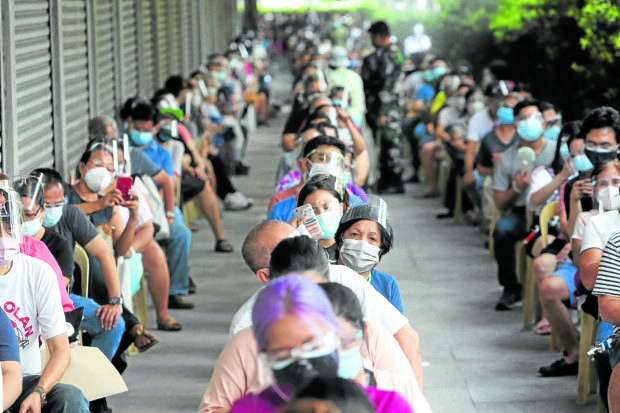
CROWD DRAWER Vaccination sites offering the US-made Pfizer jabs are drawing large crowds, such as this one outside the Prince Hotel in Ermita, Manila. Authorities have warned against potential superspreader events as the government ramps up the rollout of vaccines. INQUIRER file photo / MARIANNE BERMUDEZ
MANILA, Philippines — Metro Manila, which used to be the center of surges in COVID-19 infections in April, is now officially a “low-risk” area because of its decreasing number of coronavirus cases, the Department of Health (DOH) said on Wednesday.
In an online briefing, Dr. Alethea de Guzman, the officer in charge of the DOH Epidemiology Bureau, said the capital region is “exhibiting a slow decline [in cases] after a plateau.” Its average of 685 new cases daily from June 16 to 22 is lower than the 825 daily new cases on average from the previous week, De Guzman noted.
But De Guzman said the cases had yet to go down to presurge levels, adding: “The goal now is to push it down even further so that we reach our pre-ECQ (enhanced community quarantine) levels of less than 500.”
She noted that from January to February 2021, Metro Manila logged an average of around 300 new cases daily.
The capital, along with nearby provinces Bulacan, Cavite, Laguna, and Rizal, collectively known as National Capital Region (NCR) Plus bubble, was placed under a stricter quarantine classification when cases surged in April and May. The government later eased the restrictions and put NCR Plus under general community quarantine.
De Guzman said it was still imperative that local governments maintain constant vigilance.
“This is a marathon. We are bringing down our cases, but the challenge is not just to bring it down but to sustain a low level of cases,” she said.
Active cases under 50K
While all local governments in Metro Manila have posted negative two-week case growth rates, De Guzman said Pateros, Makati, San Juan, Pasig, Pasay, and Las Piñas are still individually classified as “moderate risk” areas due to their high bed occupancy rates as of Wednesday.
The DOH’s latest tally showed 4,353 new cases of COVID-19 infections on Wednesday, which brought the country’s total case count to 1,372,232 cases.
In its daily case bulletin, the DOH said there remained 49,862 active cases or currently sick individuals. Of this number, the majority — or 90.4 percent — are mild cases, 4.5 percent are asymptomatic, 1.5 percent are in critical condition, 2.1 percent are severe cases, and 1.49 have moderate symptoms.
Wednesday’s active case count is the lowest since May 27, when there were 48,109 active cases recorded.
The DOH also reported that another 7,139 patients have recovered from the disease, bringing the total number of COVID-19 survivors in the country to 1,298,442. However, another 119 have succumbed to the illness, pushing the death toll to 23,928.
The DOH said six labs had failed to submit their data on time, and that 15 duplicate cases were removed from the total case count. Seventy-four cases previously tagged as recoveries were also reclassified as deaths following final validation.
Increase in 4 regions
According to De Guzman, the DOH flagged four regions that showed case increases and high bed occupancy rates. These are the Caraga Administrative Region, Western Visayas, Davao Region, and Soccsksargen, which have logged positive two-week case growth rates.
The average daily attack rate (ADAR) reached 9.95 cases per 100,000 population in Caraga; 8.83 in Western Visayas; 8.16 in Davao Region, and 7.01 in Soccsksargen. By comparison, Metro Manila’s ADAR — the number of new cases in an area over a two-week period, against the total population of that area — has gone down to 5.7, De Guzman said.
She also noted that ICU occupancy rate in Davao Region has reached the critical risk category at 86.73 percent. Other areas that have a high to critical health care or ICU utilization rate include Zambales, Tarlac, Pampanga, Misamis Occidental, Oriental Mindoro, and Benguet.
Despite the increasing number of COVID-19 cases in some areas, De Guzman said that overall, the trend shows “signs of decline” in the number of virus infections in the country.
At the same time, the health official warned local authorities to be prepared since the situation could easily turn. She advised local governments to prepare for sudden spikes in infections by designating in advance which regular hospital beds would be converted to COVID-19 beds.